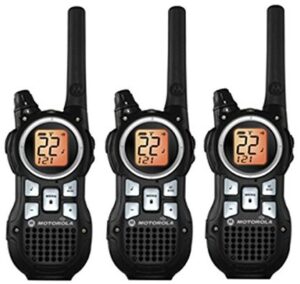Simplex operation is a direct radio-to-radio method of using a radio, in which all users receive and transmit on the same channel; it is the most common type of operation that people are familiar with. You turn on the radio, dial in a channel (or frequency), and start talking. So long as everyone is on the same channel with the same squelch settings, and everyone is in range, all parties can hear one another.

Simplex operation generally works well over shorter distances, or when communicating using a base, mobile or handheld station that’s in a high location. Since there is no repeater, coverage is generally limited to a few miles, although depending on topography, much greater ranges may be possible. It is most easily deployed in the field among groups of people.
The GMRS service has the following 22 simplex channels defined by the FCC:

You’ll notice that channels 1-7 are located between channels 15-22 in terms of frequency. Channels 8-14 are actually located between GMRS channels as well, in this case the repeater input frequencies which we’ll discuss in a later section. For this reason, channels 1-14 are known as interstitial channels, and have reduced power output and bandwidth requirements as a result, they must fit and play nicely between the main GMRS channels, 15-22, which were the original GMRS channels before the restructuring.
The reason for this arrangement is due to channels 1-14 originally being license free channels the FCC created for the Family Radio Service, or FRS. Since then, the FCC has consolidated the channels for FRS and GMRS into a common set with different power limitations, due to the rampant misuse of the GMRS service allocations associated with the sale of hybrid FRS/GMRS radios to the general public (which may no longer be sold at this time). This means the GMRS has a few more channels it can now use with slightly elevated power, but has to share its channels with the FRS.
FRS traffic is not a huge problem for GMRS in terms of interference, since the FRS is limited to lower power output than GMRS, and radios must come with non-removable antennas, which are usually very inefficient. Regardless, FRS users can definitely be heard and may require jumping around on different channels in crowded areas or use of a coded squelch to filter out. In either case, FRS users are not allowed to use repeater input channels.
One thing to keep in mind is the different power levels available on the different channels; 1-7 are limited to 5 watts, 8-14 are limited to half a watt, and 15-22 are limited to 50 watts. If everyone is using handheld radios, channels 1-7 will work just fine since they don’t typically transmit with more than 5 watts. If mobile or base station radios are involved, it may make sense to switch to 15-22 to take advantage of the extra power. 8-14 are suitable for close range communications within a mile or so, since they are limited to half a watt. As always, it’s good practice to use the least amount of power necessary to maintain reliable communications, so if everyone has access to high power radios, but is within a couple miles of each other, channels 1-7 might still be fine and it helps keep the air waves clean and free of excess interference.
